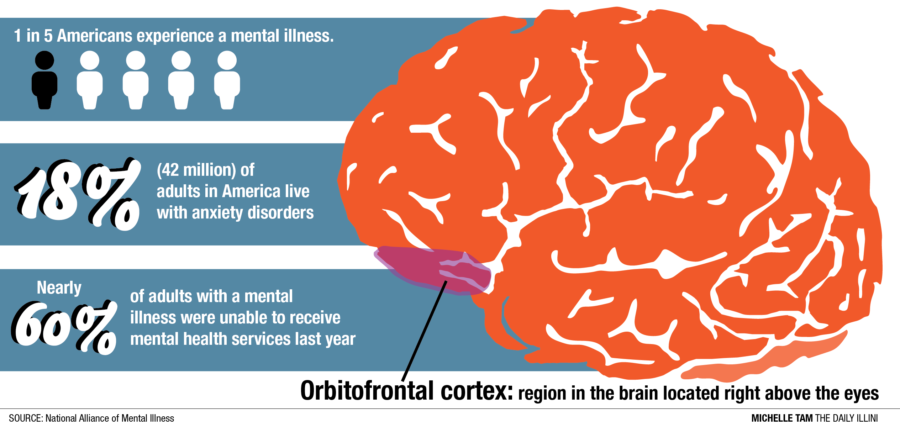UI researchers find potential way to control anxiety levels
October 26, 2015
Anxiety disorder affects roughly 44 million people in the U.S., which is one out of every five people in the country. According to Yifan Hu, a third-year psychology graduate student, treatments for the disorder average an estimated cost of $42 billion to $47 billion annually.
According to the Anxiety and Depression Association of America, anxiety disorder is the most common mental illness in the U.S. And due to its prevalence, a team of three University psychology researchers investigated why some individuals were more prone to the disorder than others.
Postdoctoral Research Associate Sanda Dolcos conducted this recent study with Florin Dolcos, her husband and psychology professor, along with Hu. Their study linked anxiety with a structure of a region in the brain, called the orbitofrontal cortex, and optimism.
Their analysis, titled “Optimism and the Brain,” was reported in the journal “Social, Cognitive and Affective Neuroscience,” and explained how the size of the orbitofrontal cortex, or OFC, affects the level of anxiety or optimism an individual has. Their findings revealed that subjects with a larger OFC had high levels of optimism and low levels of anxiety.
Get The Daily Illini in your inbox!
The OFC is a region in the brain, located above the eyes, which is responsible for the cognitive process of decision-making.
According to Dolcos, an easier way to understand what this region does is to think of it as keeping a mental tally of the value of the stimulus. An example of this is when your brain finds chocolate to be desirable, the OFC is then likely to respond to the sight of it. After eating two bars, the chocolate has lost its appeal and you will likely see a decrease in OFC response as well.
When people become anxious, they are in a situation where the OFC makes a decision that the situation is somehow affecting them negatively.
According to Hu, there have been several studies on this area in the brain, including one that studied the brains of young adults before and after the 2011 earthquake and tsunami in Japan.
Those researchers made a shocking discovery. Within four months, the OFC in their subjects shrank drastically, from what researchers assumed to be post-traumatic stress disorder, or PTSD.
“[The Japanese earthquake] study is what we based our research off of,” Dolcos said, who noticed that the size of the OFC in the Japanese subjects shrank.
Studies done on anxiety typically focus on subjects who have already been diagnosed with clinical anxiety, according to Hu, who said their study took a different angle.
Dolcos and Hu already knew about the reaction of the OFC in correlation to anxiety, but what they didn’t know was how the OFC reacted to attitudes of those who claimed to be naturally optimistic.
Their study consisted of 61 healthy young adults who had no history of having clinical medical disorders. The subjects then took a series of tests that rated their levels of optimism, anxiety, depression and various other symptoms. Hu and Dolcos then analyzed their subjects’ brains from MRI scans, calculating the amount of gray matter in relation to the brain as a whole.
This revealed that those who had a thicker or larger OFC responded with higher optimism levels and lower anxiety. This led Dolcos and Hu, based off the results from their own research and the Japanese-earthquake study, to conclude that people can manipulate the size of their OFC to reduce anxiety with proper methods.
Sophie Miller, a senior at Kansas University, said she hopes that this study can help her cope with anxiety that she recently developed.
“My anxiety became noticeable when I told my friends about my relationship last November,” Miller said. “It was an abusive relationship, so now when I talk to a guy, I get really bad anxiety.”
Situations like this are what Dolcos hopes to reduce with an anxiety-reduction method using optimism. Dolcos said to do this, if an individual trained his (or her) brain to constantly find an optimistic outcome out of the situations that caused anxiety, eventually the OFC would no longer go into panic mode, which was causing the anxiety in the first place.







